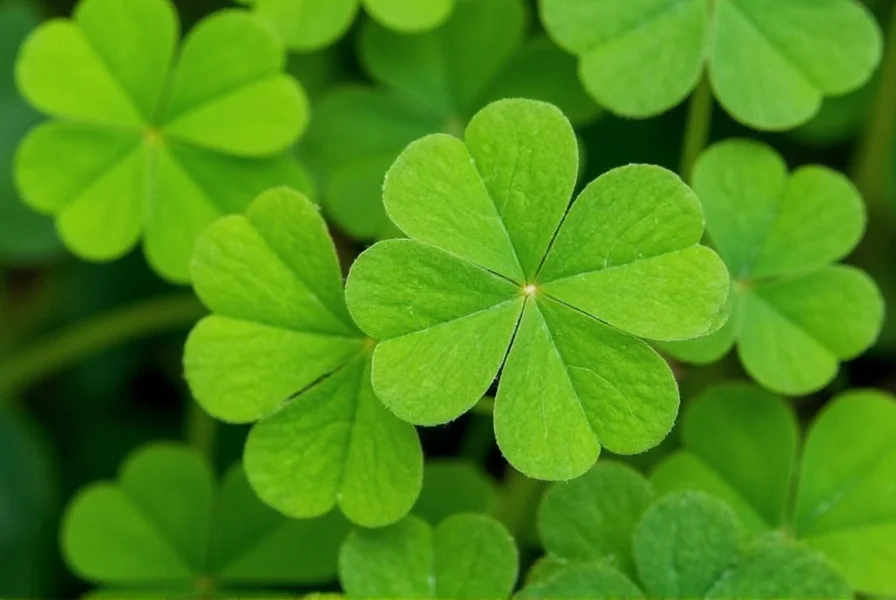Clover plants are more than just symbols of luck—they're ecologically vital members of the botanical world with significant agricultural and environmental benefits. Understanding what is the clover requires examining both its scientific classification and cultural significance across different contexts.
Botanical Classification and Characteristics
Clover belongs to the Trifolium genus, which contains approximately 300 species of herbaceous plants. The name "Trifolium" literally means "three leaves," describing the characteristic leaf structure found in most species. These plants are part of the Fabaceae (legume) family, which includes peas, beans, and lentils.
Key botanical features of clover include:
- Compound leaves typically with three leaflets (rarely four or more)
- Small flowers clustered in dense heads or spikes
- Root systems that fix atmospheric nitrogen through symbiotic bacteria
- Adaptability to various soil conditions and climates
| Species | Scientific Name | Height | Flower Color | Primary Habitat |
|---|---|---|---|---|
| White Clover | Trifolium repens | 4-8 inches | White to pink | Lawns, pastures, roadsides |
| Red Clover | Trifolium pratense | 12-20 inches | Red-purple | Meadows, fields |
| Alsike Clover | Trifolium hybridum | 12-24 inches | Pink to white | Moist soils, cultivated fields |
| Crimson Clover | Trifolium incarnatum | 12-24 inches | Bright red | Sandy soils, cover cropping |
The Four-Leaf Clover Phenomenon
When people ask what is the clover in a cultural context, they're often referring to the four-leaf clover. While most clover plants produce three leaflets per leaf, approximately 1 in 5,000 clover plants naturally develops a fourth leaflet due to genetic mutation or environmental factors.
The tradition of considering four-leaf clovers lucky dates back to ancient times. Each leaf traditionally represents something different:
- First leaf: Hope
- Second leaf: Faith
- Third leaf: Love
- Fourth leaf: Luck
Some clover varieties, like Microclover, have been selectively bred to produce more four-leaf specimens, though they still remain relatively rare in natural settings. Understanding the difference between clover and shamrock is important—while often used interchangeably, shamrock specifically refers to young sprigs of clover used as a symbol of Ireland.

Ecological and Agricultural Importance
Clover plays a crucial role in sustainable agriculture and ecosystem health. As nitrogen-fixing plants, clovers convert atmospheric nitrogen into a form usable by other plants, reducing the need for synthetic fertilizers. Farmers commonly use clover as:
- Cover crops to improve soil health
- Forage for livestock (particularly red and white clover)
- Components of crop rotation systems
- Nectar sources for pollinators like bees
White clover (Trifolium repens) is particularly valuable in pasture systems, providing high-protein forage while improving soil structure. Its ability to thrive in various conditions makes it a popular choice for both agricultural and ornamental purposes.
Common Misconceptions About Clover
Several misconceptions surround clover plants. One common misunderstanding is that all clovers are weeds. While they can appear in lawns, clovers actually benefit turf by fixing nitrogen and tolerating drought better than many grass species.
Another misconception involves the relationship between clover and bees. While clover does attract bees (particularly honeybees that produce distinctive clover honey), not all clover species are equally attractive to pollinators. Red clover, for example, has deeper flowers that primarily attract bumblebees with longer tongues.
Practical Applications of Clover Knowledge
Understanding what is the clover extends beyond botanical curiosity. Gardeners can use clover as a sustainable alternative to traditional lawns. Farmers incorporate it into crop rotation to enhance soil fertility. Naturalists recognize its importance in supporting biodiversity.
For those interested in foraging or herbal remedies, certain clover species have traditional medicinal uses, though proper identification is crucial as some look-alike plants may be toxic. Learning how to identify clover plants correctly ensures safe interaction with these common yet valuable plants.
Conclusion
Clover represents a fascinating intersection of botany, culture, and practical application. From the scientific perspective of what is clover as a plant genus to the cultural significance of the rare four-leaf variant, these plants have captured human interest for centuries. Their ecological benefits, agricultural value, and symbolic meaning make understanding clover worthwhile for gardeners, farmers, and anyone interested in the natural world.
Frequently Asked Questions
What is the difference between clover and shamrock?
While often used interchangeably, shamrock specifically refers to young sprigs of clover used as a symbol of Ireland, traditionally with three leaves. Clover is the broader botanical term for plants in the Trifolium genus, which includes over 300 species. All shamrocks are clover, but not all clover varieties are considered traditional shamrocks.
Why is a four-leaf clover considered lucky?
The four-leaf clover's rarity (occurring in about 1 in 5,000 plants) contributed to its association with luck. Ancient Celts believed four-leaf clovers could help spot fairies and ward off evil spirits. Each leaf traditionally represents hope, faith, love, and luck. This symbolism has persisted through centuries across various cultures.
Are all clover plants safe to eat?
Most common clover species (white and red clover) are generally safe to eat in moderation, with flowers and leaves being the most commonly consumed parts. However, some people may experience digestive issues with large quantities. Clover should not be confused with look-alike plants such as wood sorrel or shamrock oxalis, which can be toxic. Proper identification is essential before consumption.
How does clover benefit soil health?
Clover benefits soil through nitrogen fixation - a process where bacteria in root nodules convert atmospheric nitrogen into a plant-usable form. This natural fertilization reduces the need for synthetic nitrogen inputs. Clover also improves soil structure with its root system, prevents erosion, and when used as a cover crop, suppresses weeds while adding organic matter to the soil when tilled under.










 浙公网安备
33010002000092号
浙公网安备
33010002000092号 浙B2-20120091-4
浙B2-20120091-4